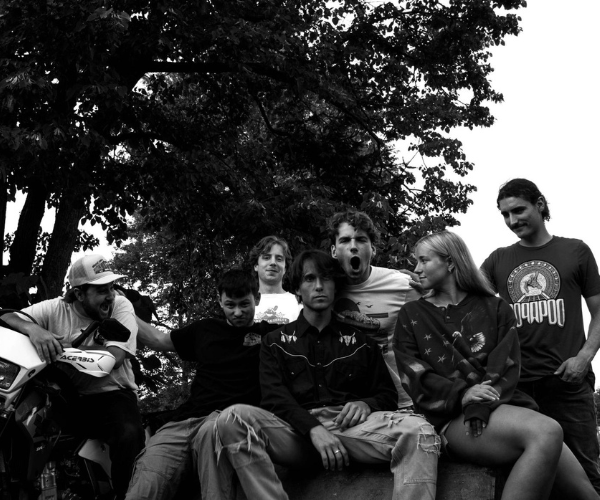It’s summer camp at Karamu House. In one corner of the basement dance rehearsal space, Terrence Spivey, a muscular man with a puka shell braided into his dreadlocks, sits on a stool, reflected in a wall of mirrors and surrounded by more than 30 children ranging in age from 5 to 15. He dips his fingers into a small tub of white clown makeup and smears it on his left cheek and jaw.
The boys giggle as he traces red lipstick around his mouth, and Spivey booms: “Who wants to study the arts seriously?”
Several kids raise their hands.
“You can’t worry about putting on lipstick then,” he chides, “because it’s not about man or woman, it’s about theatricality. It’s theater. It’s art.”
On her way out of Spivey’s mime class, Ashley Strother, 15, a student at the Cleveland School of the Arts, says she’s learned a lot about mime this summer. “I also didn’t know anything about Karamu House until Mr. Spivey told us all about it,” she says.
Spivey makes sure the students know that Karamu House is the oldest African-American cultural institution in the country — and they now have a place in it. Karamu launched the careers of Langston Hughes, Ossie Davis, Robert Guillaume, Ruby Dee and Zora Neale Hurston. Now it’s poised to launch the next generation of black playwrights and actors.
Such a notion, just a few years ago, would have seemed highly unlikely for the historic theater. Since falling on hard times in the 1980s, Karamu’s once-groundbreaking productions had become shoddy and safe. Enter Spivey, an energetic up-and-comer fresh from New York. He’s already enhanced Karamu’s educational and internship capacities by, among other things, holding this summer camp and forming a repertory company called MU Rep. (MU is how alumni affectionately refer to the theater.)
Standing in the basement hallway after class, the 41-year-old Spivey is still in full mime makeup, still talking theater.
“These kids are so hungry,” he says. “We want to bring more of them into the arts here, so they can continue their training on a different level. I want them to have pride in Karamu, pride in themselves and pride in Cleveland.”
In October 2003, after 20 years in New York, Spivey came to Cleveland with one objective: re-establish Karamu’s reputation as America’s premier black theater.
This month, Karamu kicks off its 90th season — and second full season with Spivey at the helm — with a play that reflects the theater’s original multicultural mission: a female version of “The Odd Couple” (Oct. 14-Nov. 6). Neil Simon penned the female take on this famous comedy in 1985.
“I wanted to celebrate the multicultural casting, first thing,” says Spivey, who is choosing actors for the parts based on their talent, not their race or sex.
After a good day at camp, Spivey relaxes in the conference room near the lobby. Seated in a plush leather chair next to the fireplace, under the portrait of early benefactor Leonard C. Hanna, Spivey spends the next three hours detailing his goals for Karamu. His talk, however, is peppered with frequent digressions into his first love, black theater and film history. He rattles off entire casts, directors and casting agents of plays and films he’s seen.
He talks about the theater’s extensive collection of memorabilia, including photos of Sidney Poitier and Earl Billings, who went on to appear in “Crimson Tide” and other films. On trips back from New York, Langston Hughes used to stay in the room Spivey now uses as an office (It used to be an apartment). Veteran Karamu artist Norma Powell told Spivey about Mel Stewart, who went from Karamu to “All in the Family,” “Roots: The Next Generations,” and “Made in America.”
“This theater is not just a theater,” Spivey says. “It’s the Smithsonian for black theater.”
At its beginning in 1915, a pair of Oberlin graduates, Russell and Rowena Woodham Jelliffe, opened The Playhouse Settlement, where people of all races, religions and socioeconomic backgrounds could engage in the arts together. Located at East 38th Street and Central Avenue in Cleveland’s “Roaring Third” district, the Playhouse Settlement quickly established a reputation for innovative theater, thanks to the resident Gilpin Players.
After a mysterious fire destroyed the theater in 1939, the Jelliffes moved it to its current location at East 89th Street and Quincy Avenue. Spivey says that many celebrity actors of the period such as Danny Kaye and Katharine Hepburn were moved to send donations. By 1941, the nation’s only integrated theater had gained a predominantly African-American focus, so resident actress Hazel Mountain Walker suggested changing the name to Karamu, a Swahili word that means “a place of joyful gathering, center of the community.”
Throughout its first five decades, Karamu flourished. In the post-Civil Rights era, however, Karamu began to lose some of its sparkle as theater opportunities opened for African-Americans throughout the country. The pioneering community theater also struggled with the economic challenges of operating in Cleveland, which was being devastated by urban sprawl. By 1997, when Gerry McClamy, Karamu’s executive director, took over, the theater had almost closed down. McClamy concentrated her efforts on regaining economic viability, and didn’t look for a new artistic director. (Her predecessor, Margaret Ford-Taylor, had served both roles.)
But when a young, black theater artist in New York began to query her via e-mail about the whereabouts of former alumni such as Ron “Superfly” O’Neal and make suggestions to improve the marketing copy on Karamu’s Web site, McClamy’s interest was piqued. Impressed with Spivey’s knowledge of black theater, including Karamu, she hired him to direct “The Little Tommy Parker Celebrated Colored Minstrel Show” for the 2002-03 season. While he was here, she took him around to meet the board and staff.
“Everybody liked him,” McClamy recalls.
Spivey’s easy to like. Quick with a smile or laugh, his intense passion about all things theatrical is contagious. “All he talks about is theater,” McClamy sighs.
Reverent of the hallowed halls where “every brick has a story,” Spivey knows what he wants to achieve. “I’m not about sitting on the porch and barking; I want to run with the big dogs,” he says, his fists stirring the air around him.
As a theater student at Prairie View AandM in Houston, Spivey first learned of the Karamu legacy one night while devouring several chapters in his Acting 101 textbook. In a section about four prominent African-American theaters, he came across a photo of one of his heroes, Ron O’Neal, as Othello in a Stratford-on-Avon production. O’Neal, he read, had started at Karamu. And so Spivey found a new inspiration for his budding stage career.
“Terrence brought skills I’d never seen in a young man, along with his perseverance and desire to achieve whatever he set his mind to,” recalls C. Lee Turner, Ph.D., theater arts coordinator at Prairie View. His ability to act, sing, mime and tap dance propelled him into numerous lead roles, Turner says. His Prairie View class became the first black college troupe invited to perform at Kennedy Center for the Arts in Washington, D.C., where Spivey danced and sang in “Don’t Bother Me, I Can’t Cope,” a musical revue about the African-American experience.
Spivey also earned a reputation for being a walking encyclopedia of black theater. When theater students needed to do research, Tuner says, their first stop was not the library, but Spivey. “If I see something I’m interested in, I do research,” Spivey explains.
His former professor is not surprised at his early successes at Karamu, either. “That’s just typical Terrence,” he says. “He works, works, works untiringly.”
Seeking the ultimate theater experience, Spivey moved to New York after graduation. He performed in plays when he could, and honed his skills, including studying tap dance with Henry Le Tang and the Meisner acting technique with William Esper. His first playwriting effort, “Smokestack Lightnin’, ” about a ’50s Southern juke joint, was a finalist for the 1998-99 Theodore Ward Prize for African-American Playwrights. In 2001 he became founding artistic director of the Powerful Long Ladder theater company in East Harlem.
Spivey also worked odd jobs, including as a doorman at a Midtown movie theater that housed many premieres. There, he met everyone from Robert De Niro to Wesley Snipes. Spike Lee didn’t say much when Spivey handed him his head shot postcard. But the next day, he received a call from Lee’s casting agent and ended up in an Anita Baker video.
Film was actually Spivey’s first love, thanks to his mother, Lillian Cole, who still lives in Houston. Cole would load her five children onto a bus every Saturday to see the exploding cinematic phenomenon of “blaxploitation” and martial arts movies. “We went to almost every one of those movies in the ’70s,” Cole remembers.
In high school, Spivey dreamed of a life in film, but trod the boards instead. His deepening love of theater led him to Prairie View, where he first encountered Karamu. “Knowing who started there and what they left behind, and knowing I’m walking in the same trail they walked drives me to lift up Karamu,” he says.
While Spivey’s veneration of Karamu certainly helped lead to his job there, McClamy says she also liked that he had connections to successful, contemporary African-American playwrights, actors and directors. Bringing them to Karamu is part of the plan to upgrade the level of productions and rebuild the theater’s audience and national reputation. At a recent audition for the new season, Spivey was stunned by the lineup of Equity and non-Equity actors, including Case MFA students and Great Lakes Theater Festival actors. “We certainly had a lot more and a higher quality of actors than last year,” he says.
Staging the works of the hottest new playwrights in America is another part of the plan.
“If Terrence Spivey weren’t at Karamu, I would not be interested in Karamu,” says Gregory S. Carr, an emerging St. Louis playwright whose “Johnnie Taylor is Gone” was a surprise hit of Karamu’s past season. “He believes in supporting young writers and giving them a voice.” The two correspond by e-mail at least once a week.
By most accounts, Spivey’s partial season in 2003-04 and first full season in 2004-05 were successes. In April 2004, the Cleveland Theater Collective (CTC) nominated Karamu for a theater renaissance award, and in August, it won the Black Theater Network (BTN) Pathfinder Award for Contributions to Black Theater. This August, CTC nominated Karamu for three awards. Nina Dominque won best actress for her performance in Karamu’s production of “For Colored Girls Who Have Considered Suicide When the Rainbow is Enuf.”
Though he has received an abundance of glowing press since his arrival, and audiences in general were up 50 percent last season, according to his accounting, Spivey did take some blows from local critics for the show he directed in April, “Split Second.” Most of the criticism centered on the uneven performances of the actors. “I can’t hit home runs every time,” he says.
Last season, Spivey was one of seven playwrights who wrote Great Lakes Theater Festival’s educational outreach play, and in May, he will participate in the Cleveland Play House’s new FusionFest.
“Terrence is great within the African-American community, but he’s also reaching out to other professional theater companies,” says Charlie Fee, producing artistic director for GLTF. “So it was fantastic to have him work with us.” In the past, most artistic directors considered other theaters as competition, but in today’s tight economic climate, more Cleveland theaters are collaborating to share costs and foster a unified theater community. Spivey says there’s plenty of room for everyone.
Spivey’s returned to the past for this season’s theme, Raising the Roof Revivals, a selection of plays previously performed at Karamu (except for “The Odd Couple”). Each reflects an aspect of Karamu’s ongoing mission. “Black Nativity” (Dec. 9-30) will celebrate its 20th anniversary as the theater’s holiday heart-warmer. “The Colored Museum” (Jan. 27-Feb. 19) examines some of the distinctive characteristics of the African-American community “under the microscope,” while “Before It Hits Home” (March 10-April 9) zeroes in on one serious issue: seemingly heterosexual men who maintain homosexual relations “on the down-low.”
“That play gets back to how some of us within the community are in denial or are ignorant about having safe sex,” Spivey says.
“This is a very real epidemic that we have to reveal and bring out,” he continues in a defiant tone his predecessors would have admired. “We can’t play it safe.”
A realistic idealist, Spivey expects a range of audience responses. “Some will sweat, some will smile, some will get upset and walk out,” he says, shrugging his broad, dreadlock-draped shoulders. “But no matter how you feel, you’re going to talk about it, share it with someone else, and that’s what we want. So this piece is going to be a big, big thing.”
The play Spivey loves most this season, however, is “Dream on Monkey Mountain” (April 28-May 21), which he will direct. Spivey will employ Karamu’s resident dance company led by Michael Medcalf and will use drums, stilt-walkers, masks and colorful costumes to heighten the play’s magic realism.
“It’s a very heavy piece about a man searching for himself and his racial identity, which even extends to how light or dark his skin is,” Spivey explains. He witnessed that friction firsthand while working in hotels in New York, where many of the workers were from Jamaica, Haiti or Africa.
“He knows; he pays attention,” says Glenngo King, his friend and mentor in New York for 20 years.
“I told Terrence that restoring Karamu’s fine tradition would be just about as wonderful a thing as he could do,” says author James V. Hatch, another of Spivey’s New York mentors. “He agreed.”



